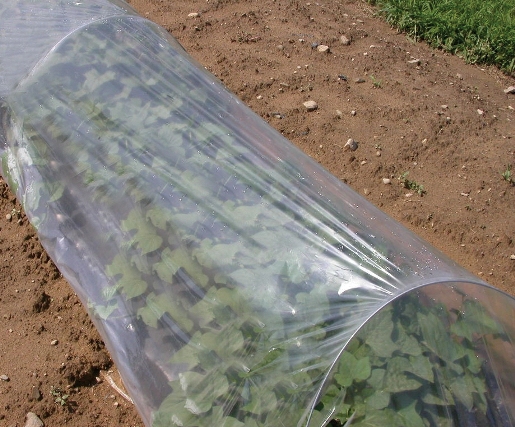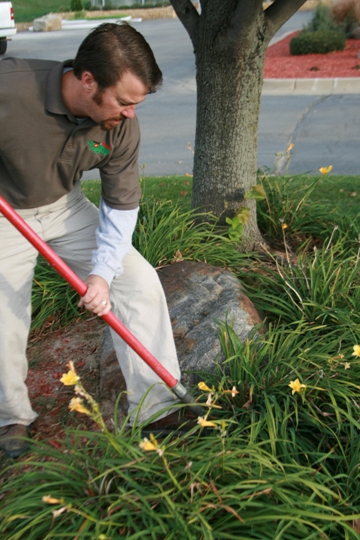Stop right there! Don’t put away your gardening tools yet. Just because the days are getting shorter and cooler does not mean that your gardening has to end. There are countless endeavors awaiting your attention throughout your garden and landscape. It’s time to grab your gloves and overshoes and get busy.
Salvage

Salvage what you can. If you have a bunch of green tomatoes on the vine, don’t panic! Simply pull them and hang them in your garden shed. By uprooting them, you trigger quicker ripening and within a couple weeks they are ready for you to freeze or can. By saving them this way, the fruit can absorb more nutrients from the vine than when picked green. You can do the same for peppers. If you don’t have the room to bring them in, simply pull the plant up and lay it on a bed of straw or mulch. You will still need to protect them from frost during the evening with a blanket or row cover.
If you do not have a row cover or cold frame, consider getting one. These simple structures can be used to extend the season of your cool-loving crops by weeks or months! They are affordable little plant havens that can be used to cover peas, spinach, kale, Swiss chard, broccoli and cauliflower, just to name a few. These crops love the cool weather and can tolerate a frost or light freeze, especially if they are protected. You will be amazed at how long into the winter you will be able to harvest with minimal investment. You can also use them to get a jump on the season in the spring. Preserving and protecting your produce will undoubtedly increase your yields.
I will admit that I love the smell of burning leaves. However, you may as well be burning money if you don’t utilize these fall beauties in your gardening operation. You can compost them and mix them in raised beds or your soil mix next season, utilize them as mulch to keep tender perennials warm or incorporate them right into your soil and let them breakdown. Leaves are great organic material. They hold moisture, release nutrients and are perfect for increasing your soil’s microbial activity which means you have a healthier, more viable soil. Growing veggies takes a lot out of the soil, so use this time of year to replenish it. Once you discover the many benefits of utilizing leaves in your garden and landscape, you will be raking the neighbor’s yard!
(Caution: Steer clear of walnut leaves. Walnuts release a chemical which inhibits plant growth. This toxin is also secreted from the roots of walnut trees, so if you have a choice, plant your garden away from your walnuts.)
Divide and Conquer

Now is the time to divide those perennials. A lot of perennials will benefit from being divided up every couple of years. Daylilies, hostas, Black-eyed Susans and peonies are just a few that you can divide with ease. The only thing you need is a sharp spade and a place to go with the new ones. An empty corner of your property will work, or surprise an unsuspecting friend or neighbor. (They will appreciate your benevolence even more if you plant it for them.) Dig completely around the mass of roots and shoots. Remove your stock plant from the hole and you will have a mass about the size of a basketball. Divide this up so you have some roots and shoots with each division. This mass will be about the size of a softball. Plant them greenside up at the same level they were originally planted and keep watering weekly until the ground is frozen. They should take right off next spring and provide you with years of enjoyment.
Pruning Perfection
The dormant season is the best season for pruning most deciduous trees and shrubs. There are not as many bugs or fungus spores present during the dormant season. Fresh wounds make a perfect area for potential insect or disease problems to enter your tree or shrub, therefore pruning in the winter is best. After the plant has shed its leaves, it has reclaimed what nutrients it could from them. With the leaves gone, you can also see the structure of the tree and can tell what branches to prune. Always try to prune back to another branch and never leave a “stub.” Stubs have a hard time healing properly and should be avoided if possible. Also, never remove more than 1/3 of the live material in one year.
Think of Fall as a Second Spring
No one will dispute the joy and sense of satisfaction that you get when growing and harvesting your own produce. Coddling and encouraging your little seeds or transplants until they flourish and bring fourth their bounty is very gratifying. This bliss is not limited to spring and summer. You can still enjoy fresh produce long into the winter if you can offer your plants a little protection. The first thing you must consider is crop selection. Don’t fight Mother Nature; make her work to your advantage.
Choose plants that thrive in cooler temperatures. Swiss chard, beets, carrots, garlic and onions are some examples of cool-weather crops. Consider seeding some of these choices late next season and enjoy your bounty until Thanksgiving and beyond.
It is also a great time of year to find super deals on trees, shrubs and perennials. Even though they may look a little rough, chances are they are just dormant. If it is a woody shrub or tree and you are in doubt, scratch the twig. If it is green, you are good to go. If it is brown and brittle, look further. Autumn and winter can be some of the most pleasant months to work outdoors. You simply need to be a little more creative, thick skinned and patient. When the growing starts slowing; find time to enjoy the other wonders of your garden.
Sam Shroyer has a bachelor’s degree in horticulture from South Dakota State University and over 20 years of horticultural experience, it is his goal to “re-teach” the public that sustainability and self-sufficiency is well within everyone’s reach.
Related Articles & Free Email Newsletter
Easy Pre-Winter Lawn Repair Tips
Fall is the Time to Plant Garlic




Comment here